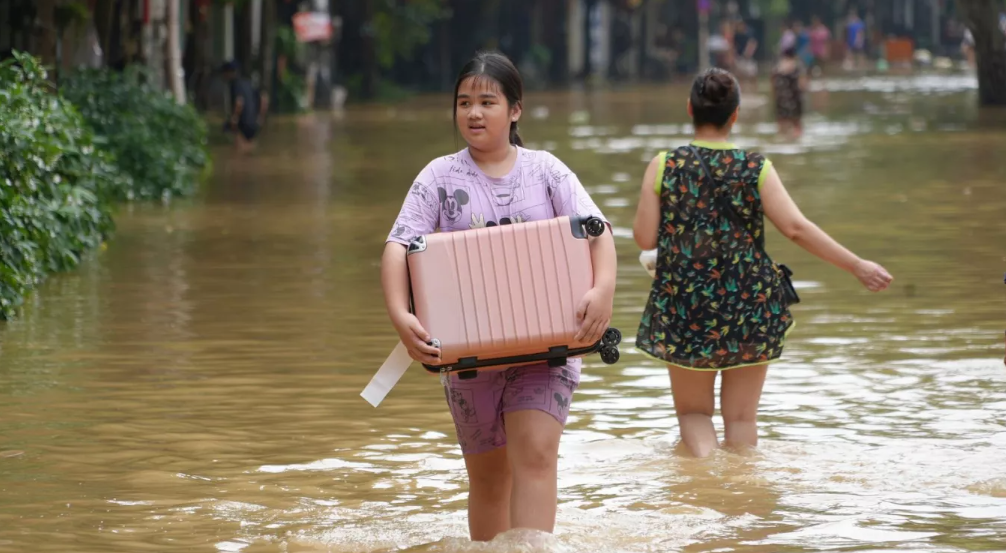
In total, 83.4 million people were living in internal displacement at year's end — the highest number ever recorded. The data highlights how climate-fueled disasters are increasingly colliding with poverty and armed conflict to uproot lives worldwide.
"Displacement is where conflict, poverty and climate meet — and it's the most vulnerable who suffer most," said Alexandra Bilak, IDMC's director.
Disaster-driven displacements reach record levels
The report reveals that weather-related disasters alone triggered 45.8 million internal displacements in 2024 — nearly double the annual average of the last decade. These movements were largely preemptive evacuations ahead of extreme weather, including devastating cyclones and floods.
Storms accounted for more than half of disaster-related displacements, with major tropical systems like Hurricane Milton in the U.S. and Typhoon Yagi in East Asia driving mass evacuations. Flooding made up 42%, affecting countries across every continent.
The United States recorded more disaster-driven displacements than any country in the history of IDMC's tracking — over 11 million in a single year.
"While these figures are sobering, they also show the effectiveness of early warning systems and evacuations in saving lives," IDMC said.
Conflict remains the biggest driver of long-term displacement
Despite the spike in climate-related events, the majority of internally displaced people — around 73.5 million — fled violence and armed conflict. In Sudan, a brutal civil war has led to 11.6 million people being displaced, the highest number ever recorded in a single country. Gaza, meanwhile, has seen nearly its entire population displaced by repeated bombardments.
Data also show that most countries experiencing high levels of conflict-driven displacement are also extremely vulnerable to climate change impacts, further compounding risks and making recovery more difficult.
Displacement risks multiply when climate and conflict intersect
According to IDMC analysis, the number of countries facing both conflict and disaster-related displacement has tripled since 2009.
"Climate change increases the likelihood of displacement and makes it harder for displaced communities to recover, especially in areas already torn by conflict," said Vicente Anzellini, IDMC's head of analysis. "When disasters hit fragile regions, the risk of long-term displacement grows exponentially."
What's needed: prevention, planning and resilience
Experts warn that as the planet continues to warm — having already likely surpassed the 1.5°C threshold — the number of people displaced by climate shocks will continue to rise.
To address this, the Global Centre for Climate Mobility (GCCM) is calling for urgent and coordinated action: from emissions cuts and better risk monitoring to stronger adaptation infrastructure and support for those who wish — or need — to move.
"There's no single fix," said GCCM deputy director Sarah Rosengaertner. "We need political leaders, local voices, and global institutions to come together to support both those who want to stay and those who must move with dignity."
She outlined four key priorities:
-
Reduce environmental degradation through better land and zoning practices;
-
Strengthen disaster preparedness and social safety nets;
-
Create support systems for voluntary relocation from high-risk areas;
-
Provide long-term solutions for displaced communities, including housing, services, and livelihoods.
The cost of inaction — and shrinking aid
Internal displacement is increasingly being recognised as a form of "loss and damage" under global climate frameworks — but experts say current funding falls far short.
"While there have been commitments on paper, the real resources to address these costs are missing," Anzellini said.
Rosengaertner warned that cuts to humanitarian aid by wealthier countries threaten to exacerbate the crisis. "These reductions undermine everything from immediate relief to data collection, making it harder to respond effectively," she said.
Still, she sees a potential turning point. "If the international community can rethink development finance — by promoting mobility, easing trade, and sharing technology — there's a chance to turn this crisis into an opportunity for resilience and justice."